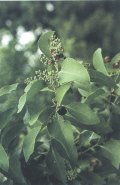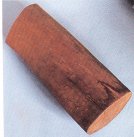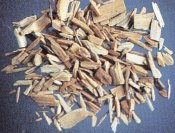Sandalwood
http://www.100md.com
《e Natural Health Center》
 |
 |
 |
 |
Qi Regulators
Sandalwood
Latin:
Lignum Santali
Origin:
Sandalwood refers to any semiparasitic plant of the genus Santalum, of the family Santalaceae, especially the fragrant wood of the true, or white, sandalwood, Santalum album L. The approximately 10 species of Santalum are distributed throughout southeastern Asia and the islands of the South Pacific.
, 百拇医药
Many other woods are used as substitutes for true sandalwood. Red sandalwood is obtained from the reddish-coloured wood of Pterocarpus santalinus, a Southeast Asian tree of the pea family (Fabaceae). This species may have been the source of the sandalwood used in King Solomon's temple.
A true sandalwood tree grows to a height of about 10 metres; has leathery leaves in pairs, each opposite the other on the branch; and is partially parasitic on the roots of other tree species. Both tree and roots contain a yellow aromatic oil, called sandalwood oil, the odour of which persists for years in such articles as ornamental boxes, furniture, and fans made of the white sapwood. The oil is obtained by steam distillation of the wood and is used in perfumes, soaps, candles, incense, and folk medicines. Powdered sandalwood is used in the paste applied to make Brahman caste marks and in sachets for scenting clothes.
, 百拇医药
Sandalwood trees have been cultivated since antiquity for their yellowish heartwood, which plays a major role in many Oriental funeral ceremonies and religious rites. The trees are slow growing, usually taking about 30 years for the heartwood to reach an economically useful thickness.
In China, sandalwood is produced in the provinces Hainan, Guangdong, Yunnan, and Taiwan.
Sandalwood picked and reaped in summer is of better quality. The heartwood is taken away, sliced or cut into pieces and included in a preparation for use when raw.
, http://www.100md.com
Properties:
Bitter in flavor, warm in nature, it is related to the spleen, stomach and lung channels.
Functions:
Activates the flow of qi, relieves pain, dispels cold and regulates the spleen and stomach.
Applications:
1. To treat cold pain in the chest and abdomen, pain in the epigastrium due to cold and vomiting with poor appetite:
, 百拇医药
a) Chest pain due to retention of cold and stagnation of qi:
This herb can be used together with yanhusuo (Rhizoma Corydalis), wild ginger (Herba Asari), long pepper (Piperis Longi), etc., e.g., Kuanxiong Wan.
b) Cold pain in the epigastrium and vomiting with poor appetite:
This herb can be ground into powder and soaked in dried ginger decoction for oral administration or used together with agalloch eaglewood (Lignum Aquilariae Resinatum), round cardamom, amomum, etc.
, 百拇医药
Dosage and Administration:
1-3 g.
Decoct this herb for oral administration. It should be decocted later.
Cautions on Use:
Reference Materials:
'Ri Huazi's Materia Medica' :
"Pain in the chest and abdomen."
, http://www.100md.com 'Herbs Traced to Shen Nong's Herbal Classic' :
"It is good at regulating the reverse flow of qi in the chest .... It can also clear obstruction in the yangming channel and dissolve stagnation."
'Essentials of Materia Medica' :
"It is a major herb for regulating qi, used to regulate the spleen and lungs and remove obstruction in the chest."
Toxic or Side Effects:
, 百拇医药
Modern Researches:
This herb contains a volatile oil with a-santalol and b-santalol as its main ingredients. It also contains santene, santenone, etc.
The perfusion of sandalwood solution into isolated frog hearts has a negative myodynamic effect and it is antagonistic to arrhythmia caused by poisoning with Sini Tang or wujiapi (Cortex Acanthopanacis Radicis)., 百拇医药